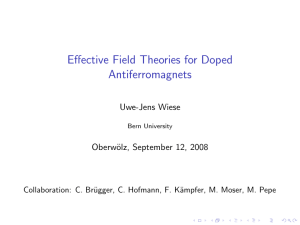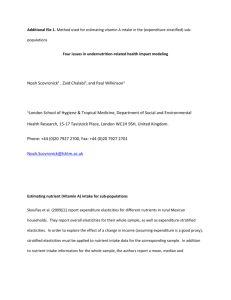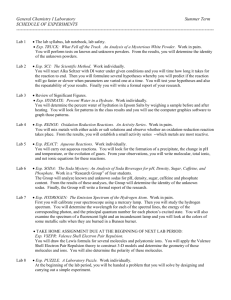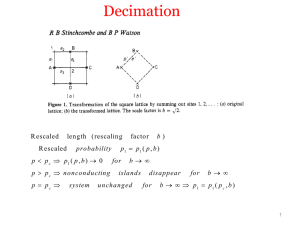Wiese
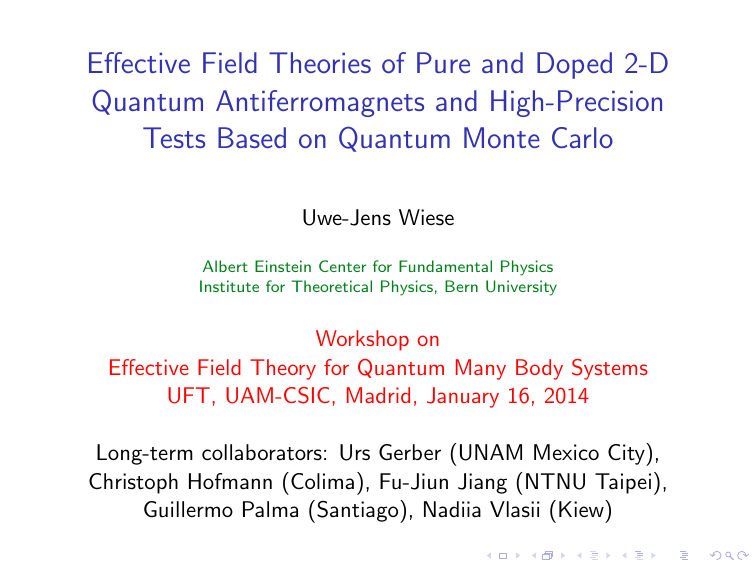
Effective Field Theories of Pure and Doped 2-D
Quantum Antiferromagnets and High-Precision
Tests Based on Quantum Monte Carlo
Uwe-Jens Wiese
Albert Einstein Center for Fundamental Physics
Institute for Theoretical Physics, Bern University
Workshop on
Effective Field Theory for Quantum Many Body Systems
UFT, UAM-CSIC, Madrid, January 16, 2014
Long-term collaborators: Urs Gerber (UNAM Mexico City),
Christoph Hofmann (Colima), Fu-Jiun Jiang (NTNU Taipei),
Guillermo Palma (Santiago), Nadiia Vlasii (Kiew)
Outline
Cuprate Superconductors and Antiferromagnets
Correspondences between QCD and Antiferromagnetism
Quantum Heisenberg Model and Magnon Effective Field Theory
Hubbard Model and Effective Field Theory for Magnons and Holes
Two-Hole States Bound by Magnon Exchange
Outline
Cuprate Superconductors and Antiferromagnets
Correspondences between QCD and Antiferromagnetism
Quantum Heisenberg Model and Magnon Effective Field Theory
Hubbard Model and Effective Field Theory for Magnons and Holes
Two-Hole States Bound by Magnon Exchange
Antiferromagnetic precursors of highT c superconductors
LaCuO YBaCuO
Properties of cuprates
Temperature-dependence of resistivity
Properties of cuprates
Temperature-dependence of resistivity
Properties of cuprates
Temperature-dependence of resistivity
Properties of cuprates
Temperature-dependence of resistivity
Outline
Cuprate Superconductors and Antiferromagnets
Correspondences between QCD and Antiferromagnetism
Quantum Heisenberg Model and Magnon Effective Field Theory
Hubbard Model and Effective Field Theory for Magnons and Holes
Two-Hole States Bound by Magnon Exchange
Phase diagrams of QCD and of doped antiferromagnets
QCD phase diagram
Phase diagram of cuprates
Quark-gluon plasma strange metal
T T hadronic phase color superconductor chemical potential antiferromagnetic phase high-temperature superconductor hole concentration
Correspondences between QCD and Antiferromagnetism
QCD Antiferromagnetism broken phase global symmetry symmetry group G unbroken subgroup H
Goldstone boson
Goldstone field in G / H order parameter coupling strength propagation speed conserved charge charged particle long-range force dense phase microscopic description effective description of Goldstone bosons effective description of charged fields hadronic vacuum chiral symmetry
SU (2)
L
⊗ SU (2)
R
SU (2)
L = R pion
U ( x ) ∈ SU (2) chiral condensate pion decay constant F
π velocity of light antiferromagnetic phase spin rotations
SU (2) s
U (1) s magnon
~ ( x ) ∈ S 2 staggered magnetization spin stiffness ρ s spin-wave velocity c electric charge U (1)
Q electron or hole baryon number U (1)
B nucleon or antinucleon pion exchange nuclear or quark matter magnon exchange highT c superconductor lattice QCD chiral perturbation theory
Hubbard or t J model magnon effective theory baryon chiral perturbation theory magnon-hole effective theory
Outline
Cuprate Superconductors and Antiferromagnets
Correspondences between QCD and Antiferromagnetism
Quantum Heisenberg Model and Magnon Effective Field Theory
Hubbard Model and Effective Field Theory for Magnons and Holes
Two-Hole States Bound by Magnon Exchange
Quantum spins S x
[ S a x on a lattice with sites x
X
, S b y
] = i δ xy
ε abc
S c x
, ~ = S x x
SU (2) invariant Hamiltonian of the quantum Heisenberg model
X
H = J S x
· S y
, [ H , ~ ] = 0 h xy i
Partition function at inverse temperature β = 1 / T
Z = Tr exp( − β H )
Staggered magnetization order parameter
M s
=
X
( − 1)
( x
1
+ x
2
) / a
S x x signals spontaneous symmetry breaking SU (2) → U (1) a
2
L 2
|h ~ s i| = M s
= 0 at T = 0
Magnon (Goldstone boson) field in SU (2) / U (1) = S 2
~ ( x ) = ( e
1
( x ) , e
2
( x ) , e
3
( x )) , ~ ( x )
2
= 1
Low-energy effective action for antiferromagnetic magnons
S [ ~ ] =
Z
0
β dt
Z d
2 x
ρ s
2
∂ i
~ · ∂ i e + c
1
2
∂ t
~ · ∂ t e
Chakravarty, Halperin, Nelson (1989)
Neuberger, Ziemann (1989)
Hasenfratz, Leutwyler (1990)
Hasenfratz, Niedermayer (1993)
Chubukov, Sentil, Sachdev (1994)
Path integral
Z = Tr[exp(
X
− ε H
1
) exp( − ε H
2
) ...
exp( − ε H
M
)]
N
= Sign[ s ] exp( − S [ s ])
[ s ] cosh(
ε t
2
) sinh(
ε
2 t
)
T exp(−
ε [
− +
2
µ
−
2d
])
X exp(− ε [ U
−
2
−
µ
−
2d
])
In this case: M = 2, t = U = J , µ = 0.
Cluster decomposition
All spins in a cluster are flipped simultaneously with probability
1
2
.
Reference configuration
Evertz, Lana, Marcu (1993); UJW, Ying (1994); Beard, UJW (1996)
Fit to analytic predictions of effective theory
(
χ s
=
M 2 s
L
2
β c c
2
3
1 + 2
ρ s
Ll
β
1
( l ) +
ρ s
Ll
β
1
( l )
2
+ 3 β
2
( l )
)
χ u
=
2 ρ s
3 c 2
(
1 +
1 c
3 ρ s
Ll e
1
( l ) +
1
3 c
ρ s
Ll
2 e
2
( l ) −
1
3 e
1
( l )
2 − 6 ψ ( l )
)
12
20000
15000
ρ s
= 0.18081(11)J c = 1.6586(3)Ja
M s
= 0.30743(1)/a
2
χ
2
/d.o.f. = 1.15
10
8
ρ s
= 0.18081(11)J c = 1.6586(3)Ja
χ
2
/d.o.f. = 1.15
L = 48a
L = 56a
L = 64a
L = 72a
L = 80a
L = 88a
L = 96a
10000
L = 48a
L = 56a
L = 64a
L = 72a
L = 80a
L = 88a
L = 96a
6
4
5000
2
0
20 30 40 60 70 80
0
20
M s
= 0.30743(1)/a
2
30 40 50
β J
60 70 80 50
β J
M s
= 0 .
30743(1) / a
2
, ρ s
= 0 .
18081(11) J , c = 1 .
6586(3) Ja
UJW, Ying (1994); Sandvik, Evertz (2010); Jiang, UJW (2010)
Excellent agreement with effective field theory predictions for the constraint effective potential: G¨
-2.5
2
-3
1.5
-3.5
1
-4
0.5
-4.5
0
-0.4
-0.2
0.2
0.4
Φ
3
-5
0.1
0.15
0.2
0.3
0.35
0.4
0.25
ψ
Heisenberg model: Gerber, Hofmann, Jiang, Nyfeler, UJW (2009)
XY model: Gerber, Hofmann, Jiang, Palma, Stebler, UJW (2011)
5
-2.5
4
-3
3
-3.5
2
-4
1
0
-0.4
-0.2
Φ
1
0.2
0.4
-4.5
0 0.05
0.15
0.2
Ψ
0.1
Jiang (2010) M = 0 .
43561(1) / a
2
, ρ = 0 .
26974(5) J , c = 1 .
1348(5) Ja
Effective rotor Lagrange function in the δ -regime β c L
L =
Z d
2 x
ρ s
2
∂ i
~ · ∂ i e +
1 c 2
∂ t
~ · ∂ t e =
Θ
2
∂ t
~ · ∂ t e
Moment of inertia
Θ =
ρ s
L
2 c 2
1 +
3 .
900265
4 π c
ρ s
L
+ O
1
L 2
Hasenfratz, Niedermayer (1993)
L
β
L
Honeycomb lattice
Jiang (2011): f s
= 0 .
26885(2) , ρ s
= 0 .
1012(1) J , c = 1 .
2900(3) Ja
Rotor spectrum
S ( S + 1)
E
S
=
2Θ
Probability distribution of magnetization M 3 = S 3 p ( M
3
) =
1
Z
X
S ≥| M 3 | exp( − β E
S
) , Z =
X
(2 S + 1) exp( − β E
S
)
S =0
Honeycomb Lattice, 836 Spins,
β
J = 60
1
×
10
1
1
×
10
0
S z
= 0: 0.5444
S z
= 1: 0.1909
S z
= 2: 0.0338
S z
= 3: 0.00283
S z
= 0: 0.5445(9)
S z
= 1: 0.1912(5)
S z
= 2: 0.0336(3)
S z
= 3: 0.00279(6)
1
×
10
-1
1
×
10
-2
1
×
10
-3
-4 -2 0
M
3
2 4
Perfect agreement without any adjustable parameters.
Outline
Cuprate Superconductors and Antiferromagnets
Correspondences between QCD and Antiferromagnetism
Quantum Heisenberg Model and Magnon Effective Field Theory
Hubbard Model and Effective Field Theory for Magnons and Holes
Two-Hole States Bound by Magnon Exchange
The Hubbard Model
H = − t
X
( c x
† c y
+ c y
† c x
) + U h xy i
X
( c x
† c x
− 1)
2
, c x
= x c x ↑ c x ↓
For large repulsion U it reduces to the t J model
H = P − t
X
( c x
† c y
+ c
† y c x
) + J
X
~ x
· ~ y
P h xy i h xy i which further reduces to the Heisenberg model at half-filling
X
H = J
~ x
· ~ y h xy i
The Hubbard Model
H = − t
X
( c x
† c y
+ c y
† c x
) + U h xy i
X
( c x
† c x
− 1)
2
, c x
= x c x ↑ c x ↓
For large repulsion U it reduces to the t J model
H = P − t
X
( c x
† c y
+ c
† y c x
) + J
X
~ x
· ~ y
P h xy i h xy i which further reduces to the Heisenberg model at half-filling
X
H = J
~ x
· ~ y h xy i
Hole dispersion in the t J model p
2
π a
π a p
1
π
π
/2
0
-
π
/2
-
π
-
π
-
π
/2
0
π
/2
π
Hole pockets centered at lattice momenta k
α
=
π
2 a
,
π
2 a
, k
α 0
= − k
α
, k
β
=
π
2 a
π
, −
2 a
, k
β
0
= − k
β
Hole fields
ψ f
+
( x ) = √
2
ψ k
+ f
( x ) − ψ k
+ f
0
( x ) , ψ f
−
( x ) = √
2
ψ k
− f
( x ) + ψ k
− f
0
( x )
Nonlinear realization of the SU (2) s symmetry u ( x ) ~ ( x ) · ~ u ( x )
†
= σ
3
, u
11
( x ) ≥ 0
Under SU (2) s the diagonalizing field u ( x ) transforms as h ( x ) = exp( i α ( u ( x )
0
= h ( x ) u ( x ) g
†
, u
11
( x )
0 ≥ 0 , x ) σ
3
) = exp( i α ( x ))
0
0 exp( − i α ( x ))
∈ U (1) s
The composite vector field v
µ
( x ) = u ( x ) ∂
µ u ( x )
†
= iv a
µ
( x ) σ a
, v
±
µ
( x ) = v
1
µ
( x ) ∓ iv
2
µ
( x ) transforms as v
3
µ
( x )
0
= v
3
µ
( x ) − ∂
µ
α ( x ) , v
±
µ
( x )
0
= exp( ± 2 i α ( x )) v
±
µ
( x )
Transformation rules of fermion fields
SU (2) s
: ψ f
±
( x )
0
= exp( ± i α ( x )) ψ f
±
( x ) ,
U (1)
Q
D
O
R i
:
:
:
:
Q
ψ f
±
( x ) = exp( i ω ) ψ f
±
( x ) ,
D i ψ f
±
( x ) = ∓ exp( ik i f a ) exp( ∓ i ϕ ( x )) ψ f
∓
( x ) ,
O
ψ
α
±
( x ) = ∓ ψ
β
±
( Ox ) ,
O
ψ
β
±
( x ) = ψ
α
±
( Ox ) ,
R
ψ
α
±
( x ) = ψ
β
±
( Rx ) ,
R
ψ
β
±
( x ) = ψ
α
±
( Rx )
Leading terms in the effective Lagrangian for holes
L =
X h
M ψ f † s
ψ f s
+ ψ f † s
D t
ψ f s
+ Λ ψ f † s v s
1
ψ f
− s
+ σ f
ψ f † s v s
2
ψ f
− s f = α,β s =+ , −
+
1
2 M 0
D i
ψ f † s
D i
ψ f s
+ σ f
1
2 M 00
D
1
ψ f † s
D
2
ψ f s
+ D
2
ψ f † s
D
1
ψ f s i
Covariant derivative coupling to composite magnon gauge field
D
µ
ψ f
±
( x ) = ∂
µ
± iv
3
µ
( x ) ψ f
±
( x )
Shraiman, Siggia (1988); Wen (1989); Shankar (1989); Sushkov (1994);
Outline
Cuprate Superconductors and Antiferromagnets
Correspondences between QCD and Antiferromagnetism
Quantum Heisenberg Model and Magnon Effective Field Theory
Hubbard Model and Effective Field Theory for Magnons and Holes
Two-Hole States Bound by Magnon Exchange
Magnon exchange
~p
+
~p
−
′ f
+ f
−
~q
~p
− f
˜
− f
˜
+
~p
+
′
One-magnon exchange potentials
V
αα
V
αβ
( ~ ) = γ
( ~ ) = V sin(2 ϕ )
βα r
(
2 r ) =
,
γ
V
ββ
( ~ ) = − γ cos(2 ϕ )
, γ = r 2 sin(2 ϕ )
, r 2
Λ
2
2 πρ s
Two-hole Schr¨ αβ pair
−
V
1
M
αβ
0
∆ V
( ~ ) −
αβ
1
M
0
( ~ )
∆
Ψ
1
( ~ )
Ψ
2
( ~ )
= E
Ψ
1
( ~ )
Ψ
2
( ~ )
Making the ansatz
Ψ
1
( ~ ) ± Ψ
2
( r ) = R ( r ) χ
±
( ϕ ) for the angular part of the wave function one obtains
− d
2
χ
±
( ϕ ) d ϕ 2
± M
0
γ cos(2 ϕ ) χ
±
( ϕ ) = − λχ
±
( ϕ )
1
0.5
0
-
0.5
-
1
-
3
-
2
-
1 0 j
1 2 3 looks like s-wave, but turns out to be p-wave
Two-hole bound states of αβ and αα pairs
1
0.5
0
-
0.5
-
1
-
3
-
2
-
1 0 j
Angular wave function
1
1
0.5
0
-
0.5
-
1
-
1.5
-
2
-
3
-
2
-
1 0 1
2 3
2 3
Probability density
Outline
Cuprate Superconductors and Antiferromagnets
Correspondences between QCD and Antiferromagnetism
Quantum Heisenberg Model and Magnon Effective Field Theory
Hubbard Model and Effective Field Theory for Magnons and Holes
Two-Hole States Bound by Magnon Exchange
Topologically conserved current j
µ
( x ) =
1
8 π
ε
µνρ
~ ( x ) · [ ∂
ν e ( x ) × ∂
ρ
~ ( x )] , ∂
µ j
µ
( x ) = 0
Topological winding number n [ ~ ] =
Z d
2 x j t
=
1
8 π
Z d
2 x ε ij
~ · [ ∂ i
~ × ∂ j
~ ] ∈ Π
2
[ S
2
] =
Z
,
Schwarz inequality for the energy
Z
E [ ~ ] = d
2 x
ρ s
2
∂ i
~ · ∂ i
~ ≥ 4 πρ s
| n [ ~ ] |
Selfduality condition
∂ i
~ + ε ij
∂ j
~ × e = 0 is satisfied by Skyrmion configurations e
ρ,γ
( r , χ ) =
2 r ρ r 2 + ρ 2 cos( χ + γ ) , r 2
2 r ρ
+ ρ 2 sin( χ + γ ) , r 2 r 2
− ρ 2
+ ρ 2
Single-Hole-Skyrmion Hamiltonian
H f
Ψ f
(
H r , χ, γ f
++ , −−
) =
= −
2
H
H f
++ f
− +
"
1
M 0
∂ r
2
H
H f
+ − f
−−
+
1 r
∂ r
Ψ
Ψ
−
1 r 2 f
+ f
−
( x )
( x )
= E f
Ψ f
( x ) ,
ρ
2
− i ∂
χ
± r 2 + ρ 2
2
#
H f
+ −
∗
+
2 I
1
( ρ )
= H f
− +
=
− i ∂
γ
∓
√
2Λ σ f r 2
ρ 2
2 r 2
ρ
+ ρ 2
, exp i
+ ρ 2 h
2 χ + γ + σ f
π i
4
Single-hole-Skyrmion wave function
Ψ f m
+
, m
−
, m
( r , χ, γ ) =
σ f
ψ
+
( r ) exp i m
+
χ − σ f
ψ
−
( r ) exp i m
−
χ + σ f
π
8
π
8 exp( i ( m − exp( i ( m +
1
2
) γ )
1
2
) γ )
Two hole-Skyrmion wave function
Ψ
αβ
m
α
+
,, m
α
−
, m
β
+
ψ
++
( r
α
− ψ
+ −
( r
α
, r
β
) exp i h
−
ψ
− +
ψ
−−
( r
α
( r
, m
β
−
α
,
, r
β
, r
β r
, m
β
( r
α
) exp
, χ
) exp i
) exp i i
α h
, r m
β h m h
α
+
, χ
α
− m
α
−
χ m
α
+
α
χ
β
χ
α
α
, γ
+
+
+
) = m m
β
+ m
β
+
χ
β
−
β
χ
α
+ m
β
−
χ
χ
β
χ
β i
β exp( i i
( m − 1) γ )
− π
4 i exp( im γ )
+ i
π
4 exp( i exp( im γ )
( m + 1) γ )
90 degrees rotation of two-hole-Skyrmion ground state
O
Ψ
αβ
− 1 , 1 , − 1 , 1 , 0
( r
α
, χ
α
, r
β
, χ
β
, γ ) = − i Ψ
αβ
− 1 , 1 , − 1 , 1 , 0
( r
α
, χ
α
, r
β
, χ
β
, γ )
The bound state of two holes localized on a Skyrmion again has p-wave symmetry and is thus not a candidate for a preformed
Cooper pair in a high-temperature superconductor.
Vlasii, Jiang, Hofmann, UJW (2012)
Outline
Cuprate Superconductors and Antiferromagnets
Correspondences between QCD and Antiferromagnetism
Quantum Heisenberg Model and Magnon Effective Field Theory
Hubbard Model and Effective Field Theory for Magnons and Holes
Two-Hole States Bound by Magnon Exchange
Hubbard model on the honeycomb lattice:
Unbroken SU (2) s symmetric phase (graphene)
3
2.5
2
1.5
1
0.5
0
-4
-3
-2
-1
0
1
2
3
4
-3
-2
-1
0
1
2
3
Honeycomb Brillouin zone lattice
Dispersion relation
Effective Dirac Lagrangian for free graphene
X
L = ψ f s
γ
µ
∂
µ
ψ f s f = α,β s =+ , −
Hole dispersion in the t J model (Na x
CoO
2
· yH
2
O)
0.09
0.08
0.07
0.06
0.05
0.04
0.03
0.02
-4
-3
-2
-1
0
1
2
3
4
-3
-2
-1
0
1
2
3
Effective Lagrangian for Magnons and Holes
L =
X
M ψ f † s
ψ f s
+ ψ f † s
D t
ψ f s
+
1
2 M 0
D i
ψ f † s
D i
ψ f s f = α,β s =+ , −
+ Λ ψ f † s
( isv s
1
− σ f v s
2
) ψ f
− s i
+
ρ s
2
∂ i
~ · ∂ i e +
1 c 2
∂ t
~ · ∂ t e
Conclusions
• Doped antiferromagnets are described quantitatively by systematic low-energy effective field theories for magnons and doped holes.
• Quantum Monte Carlo calculations using the loop-cluster algorithm yield the low-energy parameters with fraction of a per mille accuracy.
• After fixing the low-energy parameters, the Monte Carlo data provide a very high-accuracy quantitative test of the magnon effective theory.
• Through the Shraiman-Siggia coupling , magnon exchange binds hole pairs in the p-wave channel.
• Two holes localized on a Skyrmion again have p-wave symmetry . Only if binding also exists in the d-wave channel, such states may be a candidate for a preformed Cooper pair in a highT c superconductor.
• Systems on the honeycomb lattice as well as electron-doped systems have been investigated with the same techniques.
• On the honeycomb lattice, two holes bound by magnon exchange have f-wave symmetry.
